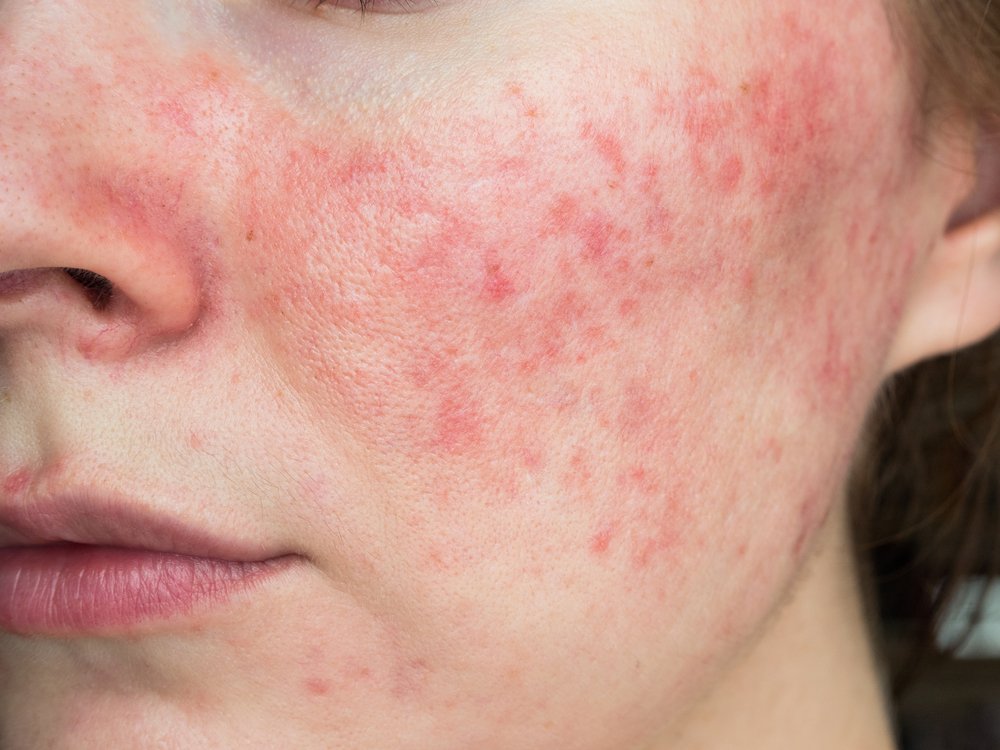
What is it?
More than 3 million cases of rosacea are diagnosed in the US each year. Rosacea is multifactorial, with its exact etiology not understood. Multiple causes have been shown to have some influence with the most common being abnormalities in facial vascularity, immune hyperreactivity, sun damage, and hypersensitivity reactions to Demodex mites commonly found on the human face. Physical appearance of rosacea can be described as redness, fine broken blood vessels, and small bumps most often on the cheeks, nose and forehead. Rosacea affects men and woman of all skin types but tends to present itself in lighter Fitzpatrick skin types I-II and in the 4th decade of life.
Types of Rosacea
Rosacea is commonly broken down into 4 subcategories: erythematotelangiectatic, papulopustular, phymatous, and ocular. Erythematotelangiectatic rosacea presents as persistent centrofacial flushing or redness with telangiectasias. The papulopustular subtype presents as scattered erythematous papules and pustules. Phymatous rosacea shows as thicken enlarged nodular skin most often on the nose of older men. The symptoms of ocular rosacea include burning, stinging, dryness, and photosensitivity. Patients with ocular rosacea typically present with recurrent eye inflammation which can manifest as eye irritation/redness, and eyelid crusting/dandruff, swelling, redness and pain.
Treatment and Common Triggers
There is no cure for rosacea as it is a chronic disease. The aim of treatment is to manage the disorder by minimizing flares to improve the patient’s quality of life. The ideal therapy depends on the subtype of rosacea. For erythematotelangiectatic rosacea, laser therapy, such as intense pulsed light therapy (IPL) and/or topical vasoconstrictors, are helpful. Other treatments include sodium sulfacetamide-sulfur wash and calcineurin inhibitors like pimecrolimus and tacrolimus. Papulopustular rosacea can be treated via both topical therapies, such as metronidazole, sodium sulfacetamide-sulfur wash, benzoyl peroxide wash, azelaic acid, ivermectin, clindamycin, and erythromycin as well as oral medications, such as a tetracycline, doxycycline, minocycline and isotretinoin. Warm compresses, digital massage and oral doxycycline have been shown to alleviate the symptoms of ocular rosacea. Phymatous rosacea is treated with loop electrocautery and surgical excision which can dramatically improve one’s appearance and self-esteem.
In treating rosacea, prescriptions should always be used in tandem with education on how to prevent flares and on good skin care. Some beneficial skin care tips that we advise patients include: (1) apply broad-spectrum sunscreen with SPF 30 or higher every 2-3 hours even if working indoors, (2) avoid harsh exfoliants, fragrances, and heavy makeup, and instead opt for green tinted mineral-based makeup that neutralizes redness, and (3) recognize and avoid common triggers of rosacea such as stress, sun, heat, hot showers, temperature extremes, spicy foods, alcohol, and caffeine.
Conclusion
Rosacea can affect anyone and is commonly misdiagnosed and therefore mistreated. Knowing the common signs and symptoms can help get you to a faster diagnosis and a more beneficial treatment outcome. The skin care experts at Peach Dermatology can create a customized treatment plan to help you achieve clear and noticeable control with minimal or no flares.

